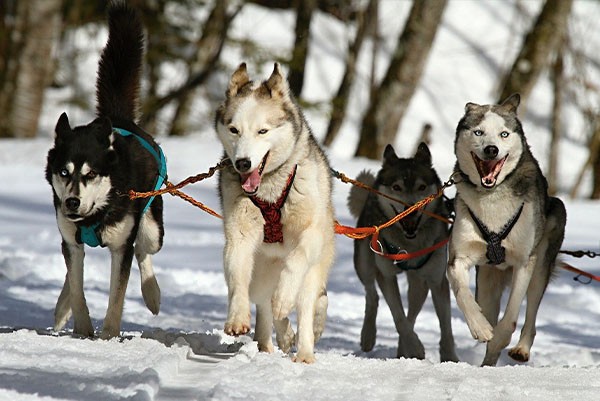The Serum Run
Ever heard of Togo and Balto? These two huskies saved the lives of many children over 100 years ago with their courage, sense of direction and fabulous stamina.
Here's the story:
In 1925, a diphtheria epidemic broke out among the population of the town of Nome in Alaska, and within a few days many young children died. There were no roads to Nome and planes could not fly due to the extremely bad weather conditions. There was also no passage for ships. To bring the cure from Nenana, 1085 km away, to Nome within five days, all hope rested on one of the oldest means of transport in Alaska, the sledge, pulled by huskies. Several experienced mushers made themselves available with their teams and were to set off from Nome and from Nenana to hand over the nine-kilogram package with the serum to each other. A race against time under cruel weather conditions began. A race over 1085 km in 127.5 hours, which went down in history as the "Serum Run".
Lead dog Togo
During the race, Togo was already 12 years old and mastered the longest and most difficult stage in temperatures as low as below -65°C and strong winds. He covered 134 km alone on the first day with musher Leonhard Seppala. In total, it was to be an unimaginable 513 km round trip for this team, on a life-threatening route over thin ice, ice floes, through forests and over high plateaus at up to 1500 metres altitude.
When Seppala got lost due to the catastrophic visibility conditions, Togo got him back on the right track, saving everyone's life.
TIMES magazine later declared Togo the most heroic animal of all time and the famous polar explorer Roald Amundsen awarded the sled dog a gold medal.
At the age of 16, Togo became increasingly unwell and eventually had to be euthanised. After his death, he was taxidermied and exhibited in a museum. Today he is said to be in the "Iditarod dog race museum" in Wasilla (Alaska). His bones have been archived at the Yale Museum in New Haven.
Togo is still considered one of the most important progenitors of the Siberian huskies. His owner Leonhard Seppala was one of the most successful mushers and most important husky breeders of the 20th century in the USA.
There are exciting books about Togo and Leonhard with impressive pictures, which can still be found in many a second-hand bookshop.
Balto
Gunnar Kaasen and his dogs took over the penultimate stage of the Serum Run in sub-zero temperatures. When he missed the last musher due to catastrophic visibility, he also drove the final stage to Nome. The team thus covered almost 90 km. Balto became far more famous than Togo because he led the team that entered Nome with the saving serum.
If you ever come to New York, you will find a statue of Balto in Central Park. After his death at the age of 14, Balto was taxidermied and is still in the Cleveland Museum of Natural History.

